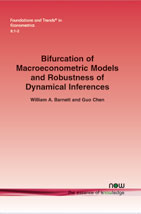Bifurcation of Macroeconometric Models and Robustness of Dynamical Inferences
By William A. Barnett, University of Kansas, Lawrence, and Center for Financial Stability, USA | Guo Chen, University of Kansas, USA
Abstract
In systems theory, it is well known that the parameter spaces of dynamical systems are stratified into bifurcation regions, with each supporting a different dynamical solution regime. Some can be stable, with different characteristics, such as monotonic stability, periodic damped stability, or multiperiodic damped stability, and some can be unstable, with different characteristics, such as periodic, multiperiodic, or chaotic unstable dynamics. But in general the existence of bifurcation boundaries is normal and should be expected from most dynamical systems, whether linear or nonlinear. Bifurcation boundaries in parameter space are not evidence of model defect. While existence of such bifurcation boundaries is well known in economic theory, econometricians using macroeconometric models rarely take bifurcation into consideration, when producing policy simulations from macroeconometrics models. Such models are routinely simulated only at the point estimates of the models' parameters.
Barnett and He [1999] explored bifurcation stratification of Bergstrom and Wymer's [1976] continuous time UK macroeconometric model. Bifurcation boundaries intersected the confidence region of the model's parameter estimates. Since then, Barnett and his coauthors have been conducting similar studies of many other newer macroeconometric models spanning all basic categories of those models. So far, they have not found a single case in which the model's parameter space was not subject to bifurcation stratification. In most cases, the confidence region of the parameter estimates were intersected by some of those bifurcation boundaries. The most fundamental implication of this research is that policy simulations with macroeconometric models should be conducted at multiple settings of the parameters within the confidence region. While this result would be as expected by systems theorists, the result contradicts the normal procedure in macroeconometrics of conducting policy simulations solely at the point estimates of the parameters.
This survey provides an overview of the classes of macroeconometric models for which these experiments have so far been run and emphasizes the implications for lack of robustness of conventional dynamical inferences from macroeconometric policy simulations. By making this detailed survey of past bifurcation experiments available, we hope to encourage and facilitate further research on this problem with other models and to emphasize the need for simulations at various points within the confidence regions of macroeconometric models, rather than at only point estimates.
Bifurcation of Macroeconometric Models and Robustness of Dynamical Inferences
Bifurcation of Macroeconometric Models and Robustness of Dynamical Inferences provides an overview of the classes of macroeconometric models for which bifurcation experiments have so far been run, and emphasizes the implications for lack of robustness of conventional dynamical inferences from macroeconometric policy simulations. By making this detailed survey of past bifurcation experiments available, the authors hope to encourage and facilitate further research on this problem with other models, and to emphasize the need for simulations at various points within the confidence regions of macroeconometric models rather than at only point estimates.
